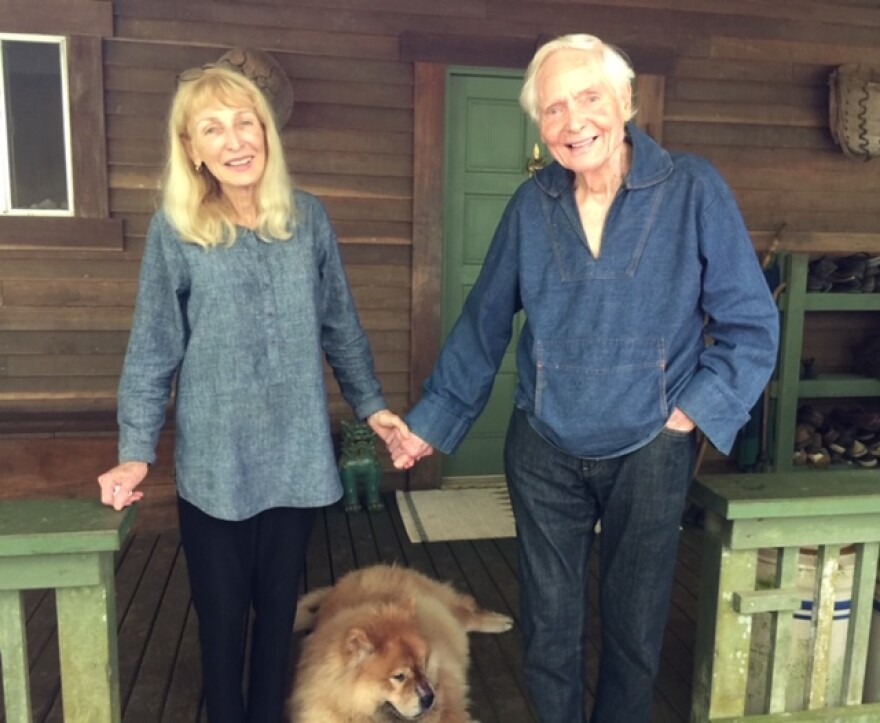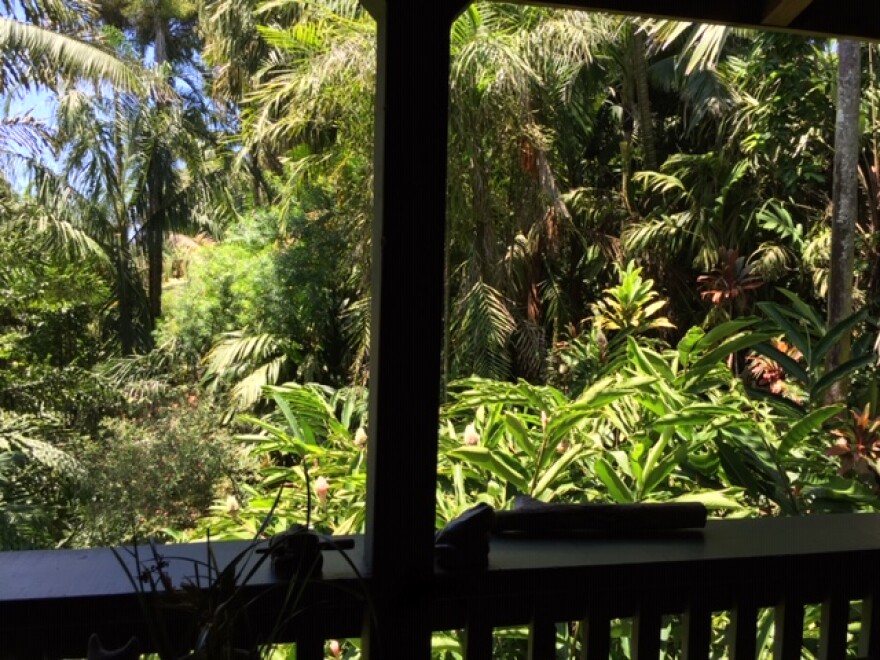Today, the last day of Poetry Month, we hear from the late W.S. Merwin, award winning U.S. Poet Laureate. He spent his last three decades cultivating a palm garden at his home in Peahi, Maui. His narrative, The Folding Cliffs, combines western epic poetry with Hawaiian chant. In 2008, HPR’s Noe Tanigawa talked with Merwin about achieving that synthesis.

In The Folding Cliffs, poet William S. Merwin recounts the story of Ko‘olau the leper, who, in the time of Hawai‘i’s cruel epidemic, refused mandatory quarantine, and went on the run with his wife, Pi‘ilani, and his son, Kaleimanu. Clinging to life together, for four years, they hid from authorities in the wilds of Kalalau on Kauai. The child, Kaleimanu, contracted leprosy and died. Ko‘olau finally succumbed, leaving Piilani to find her way.

Merwin somehow fused historical, ethnographic, environmental and emotional material into a hybrid poem/chant. How did he do it?
Merwin: I haven’t the faintest idea. (Laughs.) That’s, to me, one of the fascinating things about all the arts. You never know where something comes from.
Merwin: The Folding Cliffs, I had the idea in my head for about 12 years. I was always very cautious about using Hawaiian material in poems. It’s so tacky to do it disrespectfully and just appropriate it, I certainly wouldn’t have wanted to do anything like that. But this story was just one that I was followed around by, it wouldn’t let me alone. I couldn’t stop thinking about these people and what the real story had been, because I didn’t believe any of the versions of it.
Merwin: Then I started doing research on it I did that for about three years I still didn’t know what I was going to do with it. I thought, well, it has to be a poem. It can’t be a history and it can’t be a novel and it can’t be an essay of any kind. The only thing that can move from something like a Hawaiian chant to something like records in the Department of Health, correspondences, the only thing that’s flexible enough is poetry.

Merwin: And the Hawaiians would have told the story in poetry originally. The Kumulipo is one of the great creation epics and chants in the world. This was the way people recounted things, because of the illusion that they would last and that you could take the moment and fix it in time.
Merwin: I was thinking about how I could do it. Gradually it was beginning to take shape, the story, how it could be told. I knew it had to start quite late in the story and go back and pick it up.
Merwin: Which actually is a tradition in western narrative poems. Homer, the Odyssey and the Iliad, they both begin far along in the story. I wanted to mix the two. I wanted to have the western epic tradition and the great Hawaiian chant tradition overlay each other like double exposures, you know.

Merwin: One night I was just thinking about Pi‘ilani, very late at night. I just picked up the pencil and started to write. With her, you know.
The narrative is organized like a chant, so each verse begins with the last words in the preceding verse. Same for the sections of the book, they all pick up from the preceding ones. It’s a mechanical repetition that affects you like an undercurrent, like the rhythm of the entire work. Merwin says, when he finished he didn’t know what he had, whether it was any good, how people especially Hawaiians, would react.
Merwin: When I had done it, Paula didn’t even know what I was working on. But I guess I was rather strange for several years, because I was juggling this whole thing around in my head.
Merwin: I didn’t know when I’d finished, whether it was any good, whether anybody could understand it, whether it made any sense, whether the characters were real to anybody and what anybody, most of all the Hawaiians would ever make of it, you know.
Published in March, 2000, The Folding Cliffs was called a masterpiece by many, and a “truly original masterpiece” by Ted Hughes, who continued, “Merwin’s sinuous, infinitely flexible voice has created a new kind of narrative verse.”
Merwin: One by one, this enthusiasm came out of it. I was amazed. I’ve been extremely happy, and it’s still happening, when Hawaiians have come to me and spoken of it with enthusiasm.
Merwin: I didn’t know. I sent copies to friends, sometimes I would get no answer, but then I heard they were reading passages at funerals, things like that. The first time I read on Kaua‘i, I read first up at K?ke‘e, and all the old timers from the N?pali coast came to that reading.
Merwin: They were wonderful, there was one guy who had been on the H?k?le‘a. He started with this whole thing, what is this haole doing writing about this story, you know? He came up to me, saying, Oh I was really against the whole idea, He said, I read four pages, and I thought, Let the haole go.
In 2001, Kapalai’ula de Silva accused Merwin of insensitivity to and misrepresentation of Pi‘ilani Ko‘olau’s story. Pi‘ilani, the wife of Ko‘olau the leper, left behind a book about their lives in exile, which Merwin freely talks about using for reference in the extended interview. De Silva refers to a translation by Helen N. Frazier; you can find her paper here. Merwin used a translation by Frances N. Frazier.
The Folding Cliffs was the product of a lifetime of scholarship: the study of heraldic, western poetry, translations of medieval and classic epics from other cultures, immersion in the rhythms of the Kumulipo, plus the available facts of their lives—Ko‘olau and the woman, Pi‘ilani, who would not break her vow to stand by him in sickness and in health.
Merwin: I always wanted to be a writer, I always wanted to be a poet. I think it’s far more complicated than just the idea of having rainbowy little bursts of self expression. That’s not what the arts are about at all! We don’t know what they’re about but they’re much deeper and more complicated and harder than that. Where do they come from?

On his passing March 15, 2019, The New Yorker referenced a poem Merwin had written in 1993, entitled "For the Anniversary of My Death"
Every year without knowing it I have passed the day
When the last fires will wave to me
And the silence will set out
Tireless traveler
Like the beam of a lightless star
Then I will no longer
Find myself in life as in a strange garment
Surprised at the earth
And the love of one woman
And the shamelessness of men
As today writing after three days of rain
Hearing the wren sing and the falling cease
And bowing not knowing to what
---W.S. Merwin





